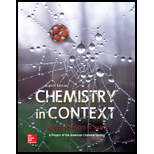
(a)
Interpretation:
The type of radiation used in MRI has to be noted.
Concept Introduction:
Magnetic resonance imaging (MRI) is technique used for medical imaging purpose. MRI uses strong magnetic field and radio waves for imaging. The principle used in MRI is same as that of NMR. NMR active nucleus like hydrogen nucleus can be detected through this device. These nuclei will absorb radio waves and emitted back it when placed in an external magnetic field, and can be detected. Since body contains water and fat in large quantities, the hydrogen nuclei from water and fat are detected through MRI and images are produced.
(b)
Interpretation:
The type of image produced and radiation used in MRI and CT has to be compared.
Concept Introduction:
Magnetic resonance imaging (MRI) is technique used for medical imaging purpose. MRI uses strong magnetic field and radio waves for imaging. The principle used in MRI is same as that of NMR. NMR active nucleus like hydrogen nucleus can be detected through this device. These nucleuses will absorb radio waves and emitted it when placed in an external magnetic field and can be detected. Since body contains water and fat in large quantities, the hydrogen nuclei from water and fat are detected through MRI and images are produced.
Computerized Tomography (CT) can take the images of internal part of body using X-rays.
(c)
Interpretation:
The reason for the abbreviation MRI is used in medical field rather than NMR, even though MRI is based on NMR has to be explained.
Concept Introduction:
Magnetic resonance imaging (MRI) is technique used for medical imaging purpose. MRI uses strong magnetic field and radio waves for imaging. The principle used in MRI is same as that of NMR. NMR active nucleus like hydrogen nucleus can be detected through this device. These nucleuses will absorb radio waves and emitted it when placed in an external magnetic field and can be detected. Since body contains water and fat in large quantities, the hydrogen nuclei from water and fat are detected through MRI and images are produced.
Want to see the full answer?
Check out a sample textbook solution
Chapter 7 Solutions
Chemistry in Context
- 6.15PM Sun Mar 30 K Draw the major product of this reaction. Include any relevant stereochemistry. Ignore inorganic byproducts. Problem 1 of O H [PhзPCH2CH3]*C|¯ NaH Drawing > Q Atoms, Bonds and Draw or tap a nearrow_forward8:17 PM Sun Mar 30 Draw the major product of this reaction. Ignore inorganic byproducts. HSCH2CH2CH2SH, BF3 Probler Drawing Ato Bonds Clarrow_forwardpresented by Mr L How the coprion. (Il Done in no wraction, dew the starting redential) доarrow_forward
- 8:16 PM Sun Mar 30 K Draw the major product of this reaction. Ignore inorganic byproducts. Proble 1. CH3MgBr 2. H3O+ F Drawingarrow_forwardо но оarrow_forwardName the major organic product of the following action of 4-chloro-4-methyl-1-pentanol in neutral pollution 10+ Now the product. The product has a molecular formula f b. In a singly hain, the starting, material again converts into a secule with the molecular kormula CIO. but with comply Draw the major organic structure inhalationarrow_forward
- Macmillan Learning Alcohols can be oxidized by chromic acid derivatives. One such reagent is pyridinium chlorochromate, (C,H,NH*)(CICTO3), commonly known as PCC. Draw the proposed (neutral) intermediate and the organic product in the oxidation of 1-butanol by PCC when carried out in an anhydrous solvent such as CH₂C₁₂. PCC Intermediate OH CH2Cl2 Draw the intermediate. Select Draw Templates More с H Cr о Product Draw the product. Erase Select Draw Templates More H о Erasearrow_forwardIf I have 1-bromopropene, to obtain compound A, I have to add NaOH and another compound. Indicate which compound that would be. A C6H5 CH3arrow_forwardProvide the reagents for the following reactions.arrow_forward
- If I have 1-bromopropene, to obtain compound Z, I have to add two compounds A1 and A2. Indicate which compounds are needed. P(C6H5)3arrow_forwardDraw the major product of this reaction. Ignore inorganic byproducts. Assume that the water side product is continuously removed to drive the reaction toward products. O CH3CH2NH2, TSOH Select to Draw >arrow_forwardPredict the major organic product(s) for the following reaction.arrow_forward
 ChemistryChemistryISBN:9781305957404Author:Steven S. Zumdahl, Susan A. Zumdahl, Donald J. DeCostePublisher:Cengage Learning
ChemistryChemistryISBN:9781305957404Author:Steven S. Zumdahl, Susan A. Zumdahl, Donald J. DeCostePublisher:Cengage Learning ChemistryChemistryISBN:9781259911156Author:Raymond Chang Dr., Jason Overby ProfessorPublisher:McGraw-Hill Education
ChemistryChemistryISBN:9781259911156Author:Raymond Chang Dr., Jason Overby ProfessorPublisher:McGraw-Hill Education Principles of Instrumental AnalysisChemistryISBN:9781305577213Author:Douglas A. Skoog, F. James Holler, Stanley R. CrouchPublisher:Cengage Learning
Principles of Instrumental AnalysisChemistryISBN:9781305577213Author:Douglas A. Skoog, F. James Holler, Stanley R. CrouchPublisher:Cengage Learning Organic ChemistryChemistryISBN:9780078021558Author:Janice Gorzynski Smith Dr.Publisher:McGraw-Hill Education
Organic ChemistryChemistryISBN:9780078021558Author:Janice Gorzynski Smith Dr.Publisher:McGraw-Hill Education Chemistry: Principles and ReactionsChemistryISBN:9781305079373Author:William L. Masterton, Cecile N. HurleyPublisher:Cengage Learning
Chemistry: Principles and ReactionsChemistryISBN:9781305079373Author:William L. Masterton, Cecile N. HurleyPublisher:Cengage Learning Elementary Principles of Chemical Processes, Bind...ChemistryISBN:9781118431221Author:Richard M. Felder, Ronald W. Rousseau, Lisa G. BullardPublisher:WILEY
Elementary Principles of Chemical Processes, Bind...ChemistryISBN:9781118431221Author:Richard M. Felder, Ronald W. Rousseau, Lisa G. BullardPublisher:WILEY





